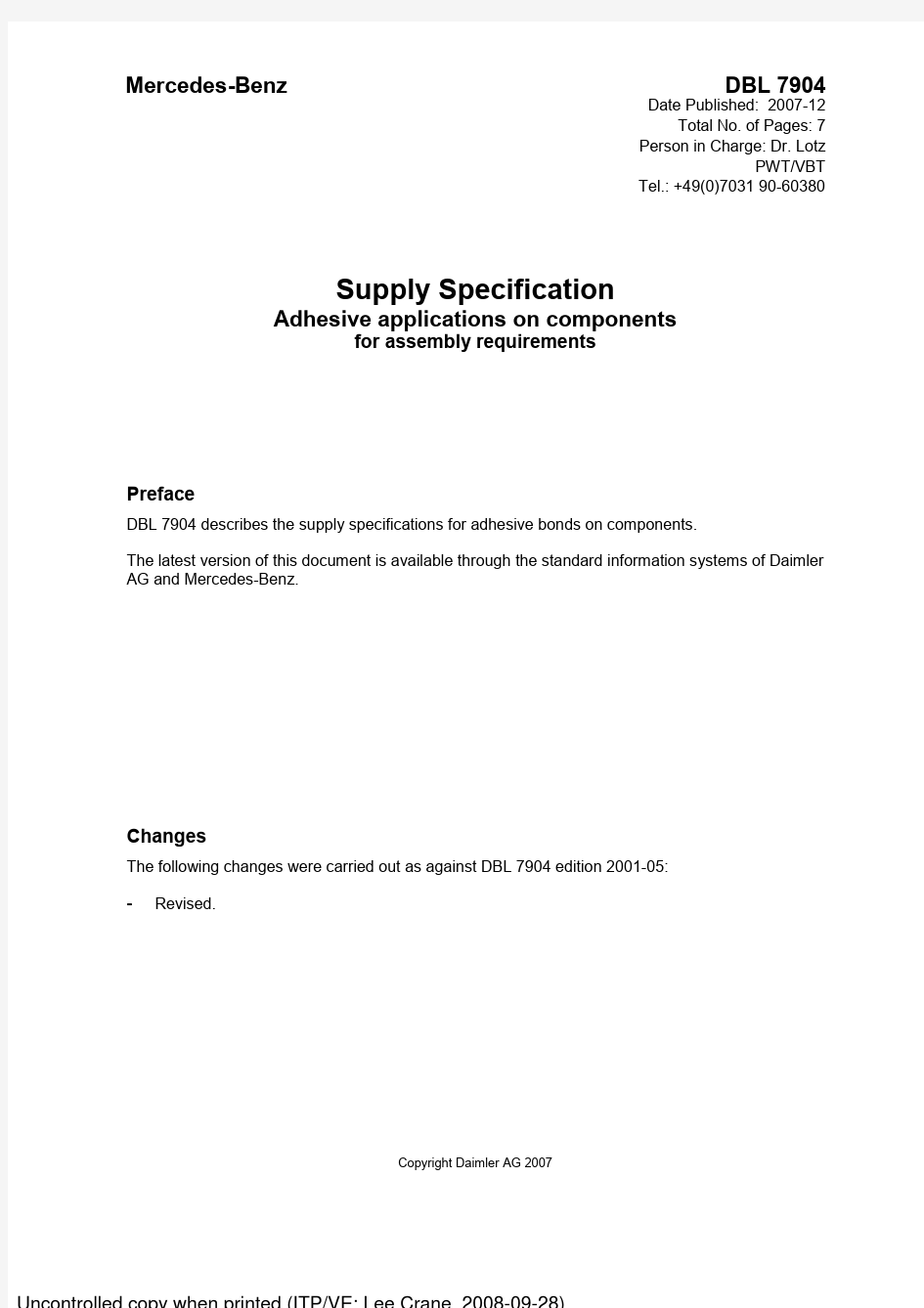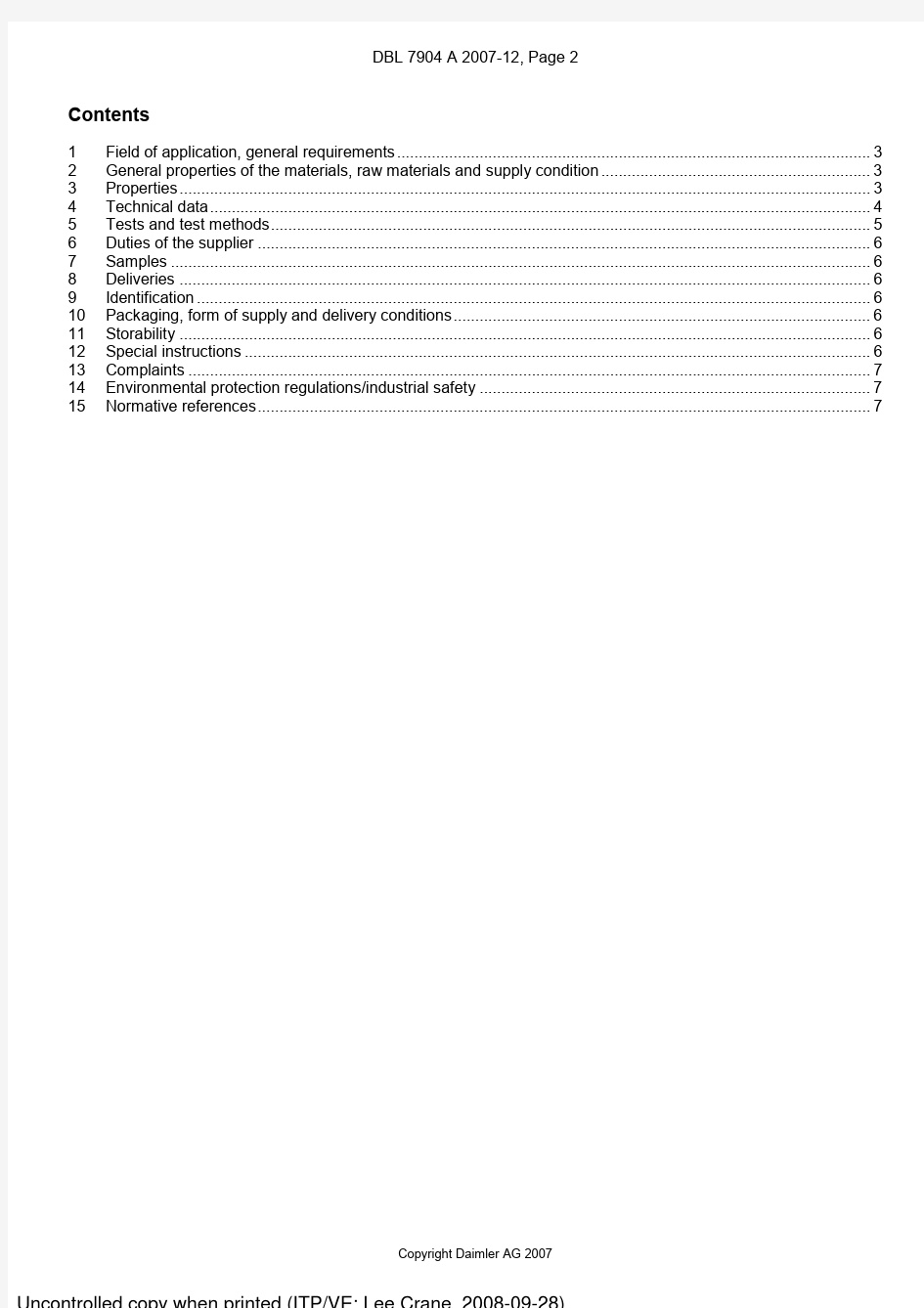DBL_7904_2007-12


Mercedes-Benz DBL 7904
Date Published: 2007-12
Total No. of Pages: 7
Person in Charge: Dr. Lotz
PWT/VBT
Tel.: +49(0)7031 90-60380
Supply Specification
Adhesive applications on components
for assembly requirements
Preface
DBL 7904 describes the supply specifications for adhesive bonds on components.
The latest version of this document is available through the standard information systems of Daimler AG and Mercedes-Benz.
Changes
The following changes were carried out as against DBL 7904 edition 2001-05:
- Revised.
Copyright Daimler AG 2007
Contents
1Field of application, general requirements (3)
2General properties of the materials, raw materials and supply condition (3)
3Properties (3)
4Technical data (4)
5Tests and test methods (5)
6Duties of the supplier (6)
7Samples (6)
8Deliveries (6)
9Identification (6)
10Packaging, form of supply and delivery conditions (6)
11Storability (6)
12Special instructions (6)
13Complaints (7)
14Environmental protection regulations/industrial safety (7)
15Normative references (7)
Overview of product versions (PV)
PV Material combination Properties Application examples
10Metal, plastic, glass,
ceramics and their com-
binations, coated and
uncoated high requirement profile:
service temperature range from
-30°C to 100°C, resistant to
automotive service products and
automotive auxiliary materials
Accessories compartment,
engine compartment, roof
modules, sliding roofs, exter-
nal add-on parts, lids such as
hoods, doors, trunk lids
20Metal, plastic, glass,
ceramics, elastomer and
their combinations,
coated and uncoated medium requirement profile:
service temperature range from
-20°C to 90°C.
Internal roof modules, internal
sliding roof applications,
joints of sealing frames such
as for heating/ventilation etc.
Abbreviated designation in the drawing block: e.g. Adhesive bond DBL 7904.20
1 Field of application, general requirements
The bonded components shall be free of production defects of any type which would impair the appearance and function.
The selection of the adhesives and the adhesive bonding methods shall be based on bonding and technical require-ments taking into account industrial safety requirements and environmental aspects (also refer to DBLs 8585, 6714 and 6565 ).
Surface pre-treatments, adhesives and process parameters for the production of the adhesive-bonded joints shall be indicated in the initial sample inspection report (ISIR). In addition, the test values required in DBL 7904 shall be listed in the ISIR.
The detailed specifications regarding tests for resistance to automotive service products and automotive auxiliary materials shall be defined depending on the requirements together with the materials engineering department of the receiving plant.
2 General properties of the materials, raw materials and supply condition
Solvent-based and solvent-free contact adhesives, one or more component reactive adhesives, hot-melt adhesives and adhesive films.
The adhesive bond shall form a single unit with the component to be supplied.
3 Properties
The bonded joint shall be reliably capable of fulfilling the requirements specified by the responsible departments dur-ing the development of the component over its service life. In addition, the bonded joint shall be capable of absorbing the required short-term and long-term loads without creeping or delamination.
In addition, the bonded joint shall not be visible more than is necessary for reasons of design. The bonded joint and the adjacent areas of the bonded components shall not change over the complete service temperature range.
The bonded joint shall have a compensating effect where materials with different coefficients of thermal expansion are joined. Tensions within the bonded parts shall not impair the aging behavior and the life of the component and the bonded joint.
4 Technical data
Product versions10 20 Test method
4.1 Short-term heat storage on component
1 hour 110°C
OK OK Section 5.3
4.2 Heat storage on component
4.2.1 7 days 100°C 4.2.3 7 days 90°C OK
-
-
OK
Section 5.3
4.3 Cold impact strength on component
4.3.1 24 hours - 30°C 4.3.2 24 hours - 20°C OK
-
-
OK
Section 5.4
4.4 Water storage on component
7 days OK OK
Section 5.5 4.5 10 cycles of alternating aging on com-
ponent
4 hours each at 80°C
4 hours at -30°C,
16 hours in acc. with DIN EN ISO-6270-2 OK OK
Section 5.6
4.6 After storage in automotive service prod-ucts
and auxiliary materials
4.6.1 30 min. in automotive service products 4.6.2 30 min. in automotive auxiliary materials OK
OK
-
OK
Section 5.7
4.7 After 1000h
storage in constant condensation water
atmosphere
in acc. with DIN EN ISO 6270-2
on component
- OK Section 5.8
4.8 After 1000h salt spray test in acc. with
DIN 50 021
on component
OK - Section 5.9 Note: OK = no findings, i.e. no changes visible on component
5 Tests and test methods
All tests performed on bonded joints shall without fail be carried out both on the component itself and on the test specimens which offer the same material combinations and surface pre-treatment as the component to be bonded. While the component test only allows an assessment of the occurrence of any delamination or other irreversible changes in the bonded joint, the specimen test (e.g. tensile shear test) will allow a determination of the adhesive strength and its deterioration as a result of the influence of aging to be made.
5.1 Determination of tensile shear strength
Refer to Test Specification PA PP PWT 3668.
5.2 Component testing
Component testing shall be performed on components whose bonded joints have been produced using the same process and the same adhesive which are intended for production.
Store the complete part under standard atmospheric conditions in accordance with DIN 50 014-23 / 50-2 for 24 hours before storing it under aging conditions in the sequence indicated under Section 4.
5.3 Heat storage
Store the test specimens / components produced in accordance with Sections 5.1 and 5.2 in a recirculating air oven in acc. with DIN 50 011 to determine their resistance towards short and long-term thermal stress. The storage period and the amount of thermal stress depend on the requirements specified under Sections 4.1, 4.2 / 4.10.2, 4.10.3 and 4.10.4.
Condition the test specimens for 24 hours in standard atmosphere in accordance with DIN 50 014-23 / 50-2 before visually assessing the bonded joints of the component or determining the tensile shear strength of test specimens. 5.4 Low temperature storage
Store the components produced in accordance with Section 5.2 in a low-temperature chamber for 24 hours to de-termine the cold impact strength. The storage temperature depends on the requirements indicated in Section 4.3. 5.4.1 Determination of the cold impact strength
Remove the component from the low-temperature chamber immediately on completion of low-temperature storage. Drop the component on a concrete floor from a height of 1 m so that the bonded joint is subjected to an impact. Then check the bonded joint for any brittle fractures or delamination.
5.5 Water storage
Submerse the components produced in accordance with Section 5.2 completely in deionised water at room tempera-ture for 7 days.
Remove the components from the water storage facility and store them under standard atmospheric conditions in accordance with DIN 50 014-23 / 50-2 for 24 hours for conditioning. Inspect the bonded joint visually.
5.6 Alternating aging
Expose the test specimens and components produced in accordance with Sections 5.1 and 5.2 to 10 cycles of alter-nating aging. These aging cycles consist of a heat/low temperature and constant condensation water exposure. One cycle consists of:
4 hours at 80°C
4 hours at -30°C
16 hours in constant condensation water atmosphere in accordance with DIN EN
ISO-6270-2.
Before assessing the components / using the test specimens for the tensile shear test, condition them for 24 hours under standard atmospheric conditions in accordance with DIN 50 014-23 / 50-2.
5.7 Storage in automotive service products or automotive auxiliary materials
Treat the component and tensile shear test specimens produced in accordance with Section 5.1 by
allowing the medium to drip on to the bonded joint. The drip frequency should be 5-10 seconds. The drip duration
is 30 minutes.
Clean off any excess medium attached to the components or tensile shear test specimens by dabbing or wiping them
with a lint-free cleaning cloth. Before visually assessing the
components / test specimens for the tensile shear test, condition them for 24 hours under standard atmospheric conditions in accordance with DIN 50 014-23 / 50-2
.
5.8 Storage in constant condensation water atmosphere
Store components and test specimens produced in accordance with Sections 5.1 and 5.2 in a constant condensation water atmosphere in accordance with DIN 50 017 KK for 1000 hours.
Before assessing the components / using the test specimens for the tensile shear test, condition them for 24 hours under standard atmospheric conditions in accordance with DIN 50 014-23 / 50-2.
5.9 Salt spray test
Store components and test specimens produced in accordance with Sections 5.1 and 5.2 in a salt spray test atmos-phere in accordance with DIN 50 021 for 1000 hours.
Before assessing the components / using the test specimens for the tensile shear test, condition them for 24 hours under standard atmospheric conditions in accordance with DIN 50 014-23 / 50-2.
5.10 Adhesion test
Inspect components visually for damage and delamination of the bonded joint. Check tensile shear test specimens after storage in room atmosphere and completion of the aging cycles specified depending on the product version and present to the materials engineering departments. A deterioration of the tensile shear strength as against the un-aged tensile shear strength of >30% is not acceptable.
6 Duties of the supplier
Refer to Mercedes-Benz Special Terms, Purchase Conditions for Production Materials and Spare Parts for
Motor Vehicles.
7 Samples
Refer to Mercedes-Benz Special Terms.
8 Deliveries
Refer to Mercedes-Benz Special Terms and DBL 5306.
9 Identification
Refer to Mercedes-Benz Special Terms and DBL 5306.
10 Packaging, form of supply and delivery conditions
Refer to Mercedes-Benz Special Terms.
11 Storability
Refer to DBL 5306.
12 Special instructions
Refer to DBL 5306.
13 Complaints
Refer to Mercedes-Benz Special Terms and Purchase Conditions for Production Materials and Spare Parts for Motor Vehicles.
14 Environmental protection regulations/industrial safety
Refer to Mercedes-Benz Special Terms and DBL 8585 - Negative substance list for the selection of materials.
15 Normative references
DBL 5306
DBL 5307
DBL 8585
DBL 6714
DBL 6565
DIN 50014-23
DIN 50011
DIN EN ISO 6270
Mercedes Benz Special Terms
PAPP PWT 3668
